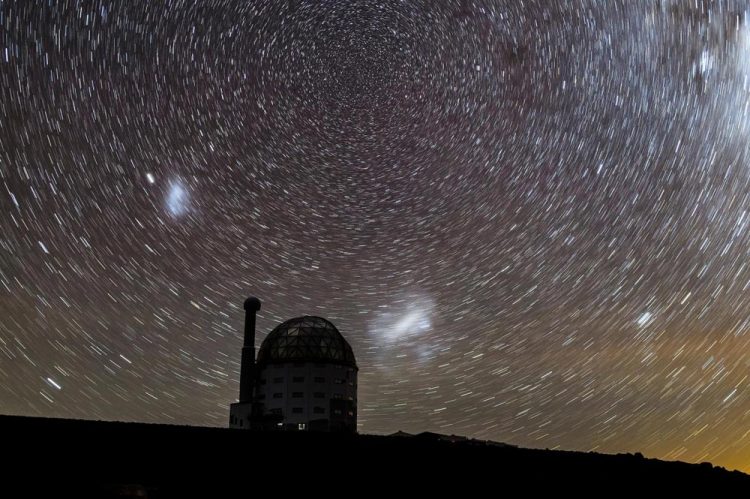Decades of research identify source of galaxy-sized stream of gas

The Magellanic Clouds are visible among star trails above the Southern African Large Telescope in South Africa. Credit: Jeff Miller/UW-Madison
With colleagues at the Space Telescope Science Institute and other institutions, astronomers at the University of Wisconsin-Madison used the Hubble Space Telescope to analyze the stream of gas. By identifying the chemical makeup of the gas, known as the Leading Arm of the Magellanic Stream, the researchers identified one branch as coming from the Small Magellanic Cloud.
The results show that the Large Magellanic Cloud is winning a gravitational tug of war with its smaller partner and will help refine models of the complex orbit controlling the dwarf galaxies' motion.
“We still don't know how the Milky Way has formed,” says Elena D'Onghia, a professor of astronomy at UW-Madison and co-author of the new report, which was published Feb. 21 in The Astrophysical Journal. “We have this huge amount of gas sitting around the Milky Way, and we still don't know its origin. Knowing where it comes from helps us understand how galaxies form, including our Milky Way.”
Visible with the naked eye from the Southern Hemisphere, the Magellanic Clouds appear as fuzzy offshoots of the Milky Way, which they orbit. In the 1970s, they were identified as the source of an enormous stream of matter — the Magellanic Stream, which includes the Leading Arm — that could be seen encircling the disk of the Milky Way.
After its discovery, Blair Savage, an emeritus professor of astronomy at UW-Madison, worked for decades to understand the gas complexes around the Milky Way, including the Magellanic Stream. He recruited several young researchers to tackle the problem during their training at UW-Madison.
Six of Savage's previous mentees, many of whom have since moved to other institutions, are co-authors of the new report.
“He's really the core reason that this all happened in Wisconsin,” says Bart Wakker, a senior scientist in the UW-Madison astronomy department who came to Madison to study the interstellar and intergalactic medium with Savage in the 1990s.
There's been a question: Did the gas come from the Large Magellanic Cloud or the Small Magellanic Cloud? At first glance, it looks like it tracks back to the Large Magellanic Cloud,” explains Andrew Fox of the Space Telescope Science Institute in Baltimore, a former graduate student of Savage's and the lead author of the study. “But we've approached that question differently, by asking: What is the Leading Arm made of? Does it have the composition of the Large Magellanic Cloud or the composition of the Small Magellanic Cloud?”
To get at the chemical composition of the Leading Arm, the researchers identified four quasars — ultra-bright galactic centers — that lie behind the stream of gas. With the Hubble Space Telescope, they then collected ultraviolet light from the quasars as it filtered through the Leading Arm. The team combined the ultraviolet light data with measurements of hydrogen using radio data, which showed an abundance of oxygen and sulfur characteristic of the Small, rather than the Large, Magellanic Cloud.
That similarity in chemical makeup is evidence that the Leading Arm was gravitationally ripped from the Small Magellanic Cloud, likely more than a billion years ago. Previous results appeared to show that the Leading Arm comes from the Large Magellanic Cloud, which suggests that galaxy-sized stream of gas may have complicated origins.
The researchers note that the new work leaves open questions about the fates of the dwarf galaxies and the matter they throw off.
“The whole point of this work is to understand what is happening to the Magellanic Clouds as they begin to merge with the Milky Way and how the gas from the clouds mixes with the gas from the Milky Way,” says Wakker. “And we're really only in the beginning stages of understanding that process.”
###
This work was supported in part by the National Aeronautics and Space Administration through grants from the Space Telescope Science Institute.
Eric Hamilton, 608-263-1986, eshamilton@wisc.edu
Media Contact
All latest news from the category: Physics and Astronomy
This area deals with the fundamental laws and building blocks of nature and how they interact, the properties and the behavior of matter, and research into space and time and their structures.
innovations-report provides in-depth reports and articles on subjects such as astrophysics, laser technologies, nuclear, quantum, particle and solid-state physics, nanotechnologies, planetary research and findings (Mars, Venus) and developments related to the Hubble Telescope.
Newest articles

First-of-its-kind study uses remote sensing to monitor plastic debris in rivers and lakes
Remote sensing creates a cost-effective solution to monitoring plastic pollution. A first-of-its-kind study from researchers at the University of Minnesota Twin Cities shows how remote sensing can help monitor and…

Laser-based artificial neuron mimics nerve cell functions at lightning speed
With a processing speed a billion times faster than nature, chip-based laser neuron could help advance AI tasks such as pattern recognition and sequence prediction. Researchers have developed a laser-based…

Optimising the processing of plastic waste
Just one look in the yellow bin reveals a colourful jumble of different types of plastic. However, the purer and more uniform plastic waste is, the easier it is to…


